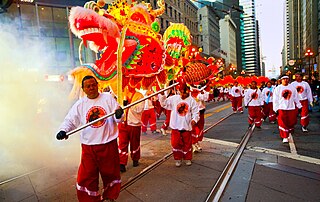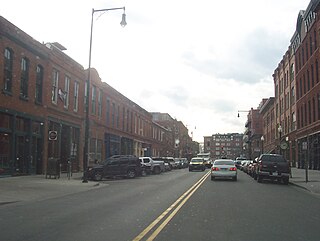Related Research Articles

The Chinatown–International District of Seattle, Washington is the center of Seattle's Asian American community. Within the Chinatown International District are the three neighborhoods known as Seattle's Chinatown, Japantown and Little Saigon, named for the concentration of businesses owned by people of Chinese, Japanese and Vietnamese descent, respectively. The geographic area also once included Seattle's Manilatown. The name Chinatown/International District was established by City Ordinance 119297 in 1999 as a result of the three neighborhoods' work and consensus on the Seattle Chinatown International District Urban Village Strategic Plan submitted to the City Council in December 1998. Like many other areas of Seattle, the neighborhood is multiethnic, but the majority of its residents are of Chinese ethnicity. It is one of eight historic neighborhoods recognized by the City of Seattle. CID has a mix of residences and businesses and is a tourist attraction for its ethnic Asian businesses and landmarks.

Chinatown is a neighborhood in Downtown Los Angeles, California, that became a commercial center for Chinese and other Asian businesses in Central Los Angeles in 1938. The area includes restaurants, shops, and art galleries, but also has a residential neighborhood with a low-income, aging population of about 20,000 residents.

Japantown is a neighborhood in the Western Addition district of San Francisco, California.

In non-Asian countries, an Asian supermarket largely describes a category of grocery stores that focuses and stocks items and products imported from countries located in the Far East.

Japantown, commonly known as J Town, is a historic cultural district of San Jose, California, north of Downtown San Jose. Historically a center for San Jose's Japanese American and Chinese American communities, San Jose's Japantown is one of only three Japantowns that still exist in the United States, alongside San Francisco's Japantown and Los Angeles's Little Tokyo.

Japantown (日本人街) is a common name for Japanese communities in cities and towns outside Japan. Alternatively, a Japantown may be called J-town, Little Tokyo or Nihonmachi (日本町), the first two being common names for Japantown, San Francisco, Japantown, San Jose and Little Tokyo, Los Angeles.

The Chinatown neighborhood in Oakland, California(Chinese: 屋崙華埠), is traditionally Chinese which reflects Oakland's diverse Chinese American, and more broadly Asian American community. It is frequently referred to as "Oakland Chinatown" in order to distinguish it from nearby San Francisco's Chinatown. It lies at an elevation of 39 feet.

Portsmouth Square, formerly known as Portsmouth Plaza, and originally known as Plaza de Yerba Buena, or simply La Plaza, is a one-block plaza in Chinatown, San Francisco, California. Portsmouth Square is the first park in San Francisco predating both Washington Square (1847) and Union Square (1850). Established in the early 19th century, during the period of Mexican California, the plaza was renamed following the U.S. Conquest of California in honor of the USS Portsmouth, the American ship which captured the city. It is bounded by Kearny Street on the east, Washington Street on the north, Clay Street on the south, and Walter Lum Place on the west.

Old Town Chinatown is the official Chinatown of the northwest section of Portland, Oregon. The Willamette River forms its eastern boundary, separating it from the Lloyd District and the Kerns and Buckman neighborhoods. It includes the Portland Skidmore/Old Town Historic District and the Portland New Chinatown/Japantown Historic District, which are listed on the National Register of Historic Places. It has been referred to as the "skid row" of Portland.
The Chinese Consolidated Benevolent Association (CCBA) is a historical Chinese association established in various parts of the United States and Canada with large Chinese communities. It is also known by other names, such as Chinese Six Companies in San Francisco, especially when it began in the 19th century; Chong Wa Benevolent Association in Seattle, Washington; and United Chinese Society in Honolulu, Hawaii. The association's clientele were the pioneer Chinese immigrants of the late 19th and early 20th centuries, who came mainly from eight districts on the west side of the Pearl River Delta in Guangdong in southern China, and their descendants. The latter wave of Chinese immigration after 1965, who emigrated from a much wider area of China and did not experience overseas the level of hostilities faced by the pioneers, did not join the CCBA, which greatly lessened its influence.

The San Francisco Chinese New Year Festival and Parade is an annual event in San Francisco. Held for approximately two weeks following the first day of the Chinese New Year, it combines elements of the Chinese Lantern Festival with a typical American parade. First held in 1851, along what are today Grant Avenue and Kearny Street, it is the oldest and one of the largest events of its kind outside of Asia, and one of the largest Asian cultural events in North America. The parade route begins on Market Street and terminates in Chinatown.

Downtown San Diego is the city center of San Diego, California, the eighth largest city in the United States. In 2010, the Centre City area had a population of more than 28,000. Downtown San Diego serves as the cultural and financial center and central business district of San Diego, with more than 4,000 businesses and nine districts. The downtown area is the home of the San Diego Symphony and the San Diego Opera as well as multiple theaters and several museums. The San Diego Convention Center and Petco Park, home of the San Diego Padres, are also located downtown. Downtown San Diego houses the major local headquarters of the city, county, state, and federal governments.

San José City Hall is the seat of the municipal government of San Jose, California. Located in Downtown San Jose, it was designed by Pritzker Prize-winning architect Richard Meier in a Postmodern style. It consists of an 18-story tower, an iconic glass rotunda, and a city council chamber wing, laid out within a two-block-long public square known as San José Civic Plaza. The tower rises 285 feet (87 m) above the plaza, making it the second tallest building in San Jose.

El Pueblo de Los Ángeles Historical Monument, also known as Los Angeles Plaza Historic District and formerly known as El Pueblo de Los Ángeles State Historic Park, is a historic district taking in the oldest section of Los Angeles, known for many years as El Pueblo de Nuestra Señora la Reina de los Ángeles del Río de Porciúncula. The district, centered on the old plaza, was the city's center under Spanish (1781–1821), Mexican (1821–1847), and United States rule through most of the 19th century. The 44-acre park area was designated a state historic monument in 1953 and listed on the National Register of Historic Places in 1972.

Chinatowns are enclaves of Chinese people outside of China. The first Chinatown in the United States was San Francisco's Chinatown in 1848, and many other Chinatowns were established in the 19th century by the Chinese diaspora on the West Coast. By 1875, Chinatowns had emerged in eastern cities such as New York City, Boston, and Philadelphia. The Chinese Exclusion Act of 1882 barred Chinese immigration to the United States, but the Magnuson Act of 1943 repealed it, and the population of Chinatowns began to rise again. In the 2010s, the downturn in the U.S. economy caused many Chinese Americans to return to China.

The San Francisco riot of 1877 was a three-day pogrom waged against Chinese immigrants in San Francisco, California by the city's majority white population from the evening of July 23 through the night of July 25, 1877. The ethnic violence which swept Chinatown resulted in four deaths and the destruction of more than $100,000 worth of property belonging to the city's Chinese immigrant population.

A Chinatown developed in Phoenix in the 1870s as the predominantly single male Chinese population self-segregated primarily to provide cultural support to each other in a place where they faced significant discrimination. They came to dominate certain types of jobs and made an impression on the greater community with their celebrations of Chinese holidays. Other aspects of their culture, primarily gambling and the smoking of opium were viewed less favorably, and in the 1890s, they were forced to establish a new Chinatown several blocks away from the prior prime downtown location, where their community would be "less visible".
There is a Japanese American and a Japanese national population in San Francisco and the San Francisco Bay Area. The center of the Japanese and Japanese American community is in San Francisco's Japantown.

Chinatown in Denver, Colorado, was a residential and business district of Chinese Americans in what is now the LoDo section of the city. It was also referred to as "Hop Alley", based upon a slang word for opium. The first Chinese resident of Denver, Hong Lee, arrived in 1869 and lived in a shanty at Wazee and F Streets and ran a washing and ironing laundry business. More Chinese immigrants arrived in the town the following year. Men who had worked on the construction of the first transcontinental railroad or had been miners in California crossed over the Rocky Mountains after their work was completed or mines were depleted in California.
Barbara L. Voss is an American historical archaeologist. Her work focuses on cross-cultural encounters, particularly the Spanish colonization of the Americas and Overseas Chinese communities in the 19th century, as well as queer theory in archaeology and gender archaeology. She is an associate professor of anthropology at Stanford University.
References
- 1 2 3 Gong-Guy, Lillian; Wong, Gerrye (2007). Chinese in San Jose and the Santa Clara Valley. ISBN 9780738547770.
- 1 2 3 Stanford Archaeology Center; Stanford University Department of Anthropology; History San Jose; Chinese Historical and Cultural Project. "Market Street Chinatown Archaeological Project" . Retrieved September 29, 2021.
- 1 2 3 "San Jose apologizes for Chinatown destruction in 1887". Los Angeles Times. Associated Press. September 28, 2021. Retrieved September 29, 2021.
- ↑ Michaels, Gina (June 2005). "Peck-Marked Vessels from the San José Market Street Chinatown: A Study of Distribution and Significance". International Journal of Historical Archaeology. 9 (2): 123–134. doi:10.1007/s10761-005-8143-6. S2CID 161761697.
- ↑ McAllister, Sue (June 1, 2012). "Artifacts exhibited from a long-buried Market Street Chinatown in San Jose". Mercury News. San Jose, California. Retrieved September 29, 2021.
- ↑ Potter, Laura; Yamane, Maya; Mau, Matthew; Lister, Brianna (June 2011). "San Jose Chinatowns Heritage Fair" (PDF). Market Street Chinatown Archaeological Project. Retrieved October 15, 2021.
- ↑ Anthropological Studies Center, Sonoma State University (April 2008). "Historical Context And Archaeological Survey Report: Heinlenville/San José Corporation Yard Archaeological Project, San José, California". pp. 22–41. Retrieved September 29, 2021.
- ↑ "Chinese American Historical Museum". Chinese Historical and Cultural Project. San Jose, California. Retrieved September 29, 2021.